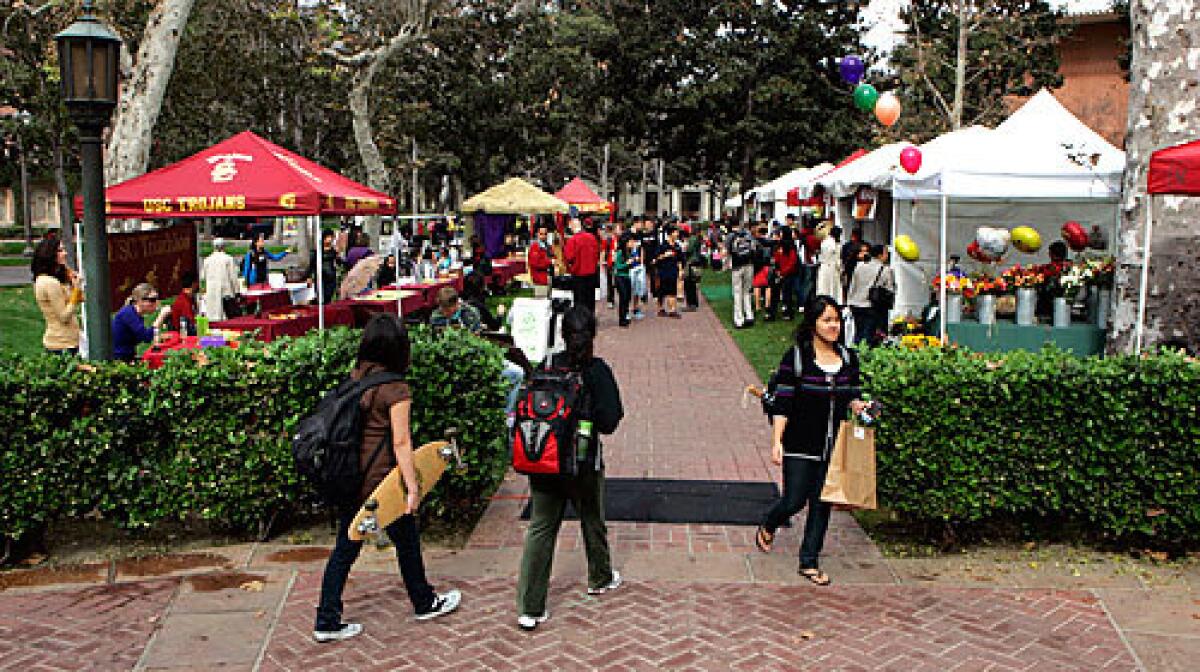Farmers markets’ new harvest: campus customers

- Share via
A growing number of colleges are finding that campus farmers markets are a great fit, tapping into students’ interest in sustaining the planet with an appealing combination of food, music and lots of people hanging out.
The idea is to be “better environmental stewards, to put a focus on where our food comes from, who grows it, how it gets to our plates,” said Kevin Chang, a student leader of the Trojan Fresh Market, a monthly market of farm foods and other products on McCarthy Quad at USC.
Choices, choices
At a recent market, the choices included fruit (Asian pears, Satsuma tangerines, apples), vegetables (multiple colors of carrots, potatoes, squash), flowers, bread and cheese. There were plenty of dorm-friendly choices: dried fruit and trail mix, dips and cookies. More than 2,000 shoppers showed up, said Scott Shuttleworth, the university’s director of hospitality. The January market added a student jazz quartet.
USC held its first market in February 2008, the result of meetings between students and university officials that began in fall 2007, Chang said.
The idea for a market had also occurred to Shuttleworth. USC is attentive to sustainable practices such as recycling, and the market provides a responsible, easy way for students, faculty and staff to buy food at a place that also promotes a sense of community, he said.
“It’s really convenient to have good food, local food, here,” said Marissa Ritchen, a freshman from Denver who was buying a pomegranate and a container of organic hummus at the November market. “It’s kind of what I am used to.”
Chang, who begins medical school at the University of Washington in the fall, said that because many students live in dorms without kitchens, it is important to offer bread, cheese and other foods that don’t require cooking. Another issue has been convincing farmers that the market would be lucrative enough for them to spend time on campus, Chang and Shuttleworth said.
To address that, USC adjusted the usual farmers market model: The university buys the products from such farms as McGrath Family Farms in Camarillo and Santa Barbara Pistachio Co. and sets up the stands on the quad. The market accepts university dining cards as well as cash, and the university’s dining services operation takes any leftover food.
At the November market, John Kiddie of Nojoqui Farms in Lompoc, was invited to campus to talk to shoppers. “I was very pleased to see that the students were interested and want better food,” he said later. His farm normally sells its wide variety of produce mostly to natural-foods distributors.
A teachable market
Shuttleworth said that having at least one farmer at the market was important to give shoppers a chance to talk with someone about “eco-friendly agriculture and organic and natural farming practices.”
“It’s part of being true to the spirit of farmers markets,” he said.
The U.S. Department of Agriculture doesn’t keep count of college farmers markets, said Debra Tropp of the agency’s Agricultural Marketing Service. But she said she believes there are not many -- yet. Markets also are being held at hospitals. Kaiser Permanente has 28 in six states; like colleges, they are places where the institution and the vendors have philosophical connections.
“In my mind, there are two incredibly big, awesome components” to campus farmers markets, said Kathryn Andersen, a founder of the Princeton University market, which opened in 2007 and is run by students.
The first is that students at the market can meet faculty and staff, and with coffee for sale and student musicians performing, people stick around. The second, she said by telephone from Italy, where she was on a Fulbright scholarship, is having an on-campus connection to agriculture.
“Students can really understand where their food comes from,” said Andersen, who grew up on a Pennsylvania farm and started a market with her family. “You can ask questions that you can’t ask in a grocery store. What type of apples are these? . . . Why would I want to eat a Stayman Winesap rather than a Pearmain?”
Among other colleges with markets are UC Davis, UC Santa Cruz and UC San Diego, as well as Stanford, Harvard, Brown, Portland State, the University of Minnesota, the University of Maine and the University of Arizona. Some markets are run by outside organizations, some with a combination of on- and off-campus sponsors.
At UC Davis, a campus book project inspired the farmers market. A committee planning events around a group reading of Michael Pollan’s “The Omnivore’s Dilemma” proposed the market. Funding from a Department of Agriculture grant and support from several campus groups, including health and dining services, led to the opening of a market on the East Quad in 2006, said Laura Rubin, a health educator in student health services. It now runs Wednesdays in the fall and spring quarters.
“The idea is really to change the environment around what foods are available,” Rubin said, citing surveys in 2005 and 2007 showing that more than half the UC Davis students ate two or fewer servings a day of fruits and vegetables. “Before the market, it wasn’t very easy, necessarily, for students to choose to eat healthy on campus.”
Shoppers at Cal Poly Pomona can choose locally grown produce every day. The Farm Store, across from the main campus, sells produce, eggs and meat produced at the school’s College of Agriculture, as well as other products in a 25,000-square-foot store, said Dawn Taccone, Farm Store manager. In addition, students from the university sell produce at farmers markets, including weekly in Irvine. And the school has a fall pumpkin patch and you-pick strawberries.
More to Read
Sign up for The Wild
We’ll help you find the best places to hike, bike and run, as well as the perfect silent spots for meditation and yoga.
You may occasionally receive promotional content from the Los Angeles Times.











